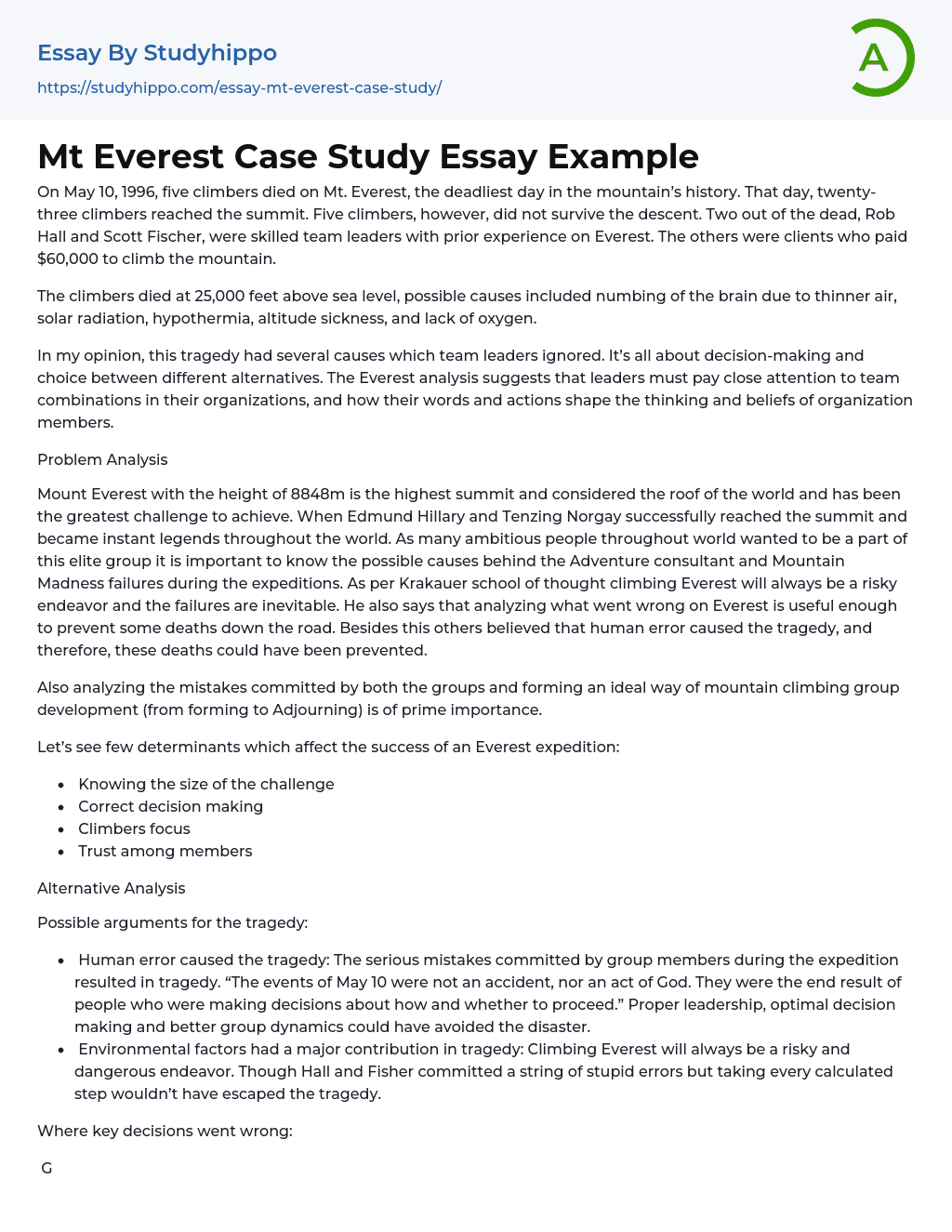On May 10, 1996, Mt. Everest experienced its deadliest day as five climbers tragically lost their lives. While twenty-three climbers successfully reached the summit, it was during the descent that the unfortunate deaths occurred. Remarkably, even seasoned team leaders Rob Hall and Scott Fischer, who had previously conquered Everest, were among those who perished. The remaining victims were clients who had paid $60,000 to join the expedition.
Possible causes for the climbers' deaths at 25,000 feet above sea level included brain numbing due to thinner air, solar radiation, hypothermia, altitude sickness, and lack of oxygen.
The tragedy was caused by team leaders' negligence, particularly in their decision-making and choice of alternatives. The Everest analysis emphasizes the significance of leaders thoroughly evaluating their teams' composition and being mindful of how their words and actions ca
...n influence the thoughts and beliefs of organizational members.
Problem Analysis
Mount Everest, also known as the highest summit and considered the roof of the world due to its impressive height of 8848m, has always been seen as the ultimate challenge. Renowned climbers Edmund Hillary and Tenzing Norgay achieved this summit, instantly becoming legendary figures worldwide. Their accomplishment served as inspiration for ambitious individuals around the globe who aspire to join this exclusive group.
However, it is important to understand why Adventure Consultant and Mountain Madness faced failure in their expeditions. According to Krakauer, climbing Everest will always involve inherent risks and failure is inevitable. Nevertheless, he argues that by analyzing the mistakes made on Everest, future fatalities can be prevented.
On the other hand, some believe that these tragedies were caused by human error and argu
that these deaths could have been avoided.
It is essential to analyze the mistakes made by both groups and establish an ideal process for the development of mountain climbing groups, from forming to adjourning.
Below are several determinants that influence the success of an Everest expedition:
- Knowing the size of the challenge
- Correct decision making
- Climbers focus
- Trust among members
Alternative Analysis
Some possible arguments that support the occurrence of the tragedy:
- Human error caused the tragedy: The serious mistakes committed by group members during the expedition resulted in tragedy. “The events of May 10 were not an accident, nor an act of God. They were the end result of people who were making decisions about how and whether to proceed.” Proper leadership, optimal decision making and better group dynamics could have avoided the disaster.
- Environmental factors had a major contribution in tragedy: Climbing Everest will always be a risky and dangerous endeavor. Though Hall and Fisher committed a string of stupid errors but taking every calculated step wouldn’t have escaped the tragedy.
The areas where key decisions went wrong were:
Group Formation:
- Recruitment of the team was not done properly with many unfit people present in the team.
- Qualification tests could have been organized to select the group members (to check the mental and medical stability of the candidates).
- Group Storming:
style="text-align: justify;">
There was no common value among the team members.
Please assess the strengths and weaknesses of both teams by referring to the analysis provided in Exhibit 1.
In conclusion, we recommend the following course of action based on justifications.
The tragedy could have been prevented or minimized with efficient leadership, optimal decision-making, and improved group dynamics. The case emphasizes the significance of developing the group based on Organizational Behavior principles. Furthermore, decisions should not be solely based on cost and overconfidence.
- Being A Leader essays
- Servant Leadership essays
- Leadership Experience essays
- Leadership Qualities essays
- Board Of Directors essays
- Brand Management essays
- Business Ethics essays
- Business Management essays
- Change Management essays
- Comparative Analysis essays
- Decision Making essays
- Dispute Resolution essays
- Knowledge Management essays
- Leadership essays
- Leadership and Management essays
- Manager essays
- Operations Management essays
- Performance Management essays
- Product Management essays
- Project Management essays
- Quality Management essays
- Risk essays
- Risk Management essays
- Scientific Management essays
- Stress Management essays
- supply chain management essays
- Time Management essays
- Total Quality Management essays
- Abnormal Psychology essays
- Abraham Maslow essays
- Attachment Theory essays
- Authority essays
- Behaviorism essays
- Classical Conditioning essays
- Cognitive Psychology essays
- Counseling essays
- Developmental Psychology essays
- Educational Psychology essays
- Erik Erikson essays
- Family Therapy essays
- Jean Piaget essays
- Maslow's Hierarchy Of Needs essays
- Mental Health essays
- Operant Conditioning essays
- Personality Psychology essays
- Positive Psychology essays
- Psychoanalysis essays
- Psychotherapy essays
- Sigmund Freud essays
- Social Psychology essays


Unfortunately copying the content is not possible
Tell us your email address and we’ll send this sample there.
By continuing, you agree to our Terms and Conditions.


